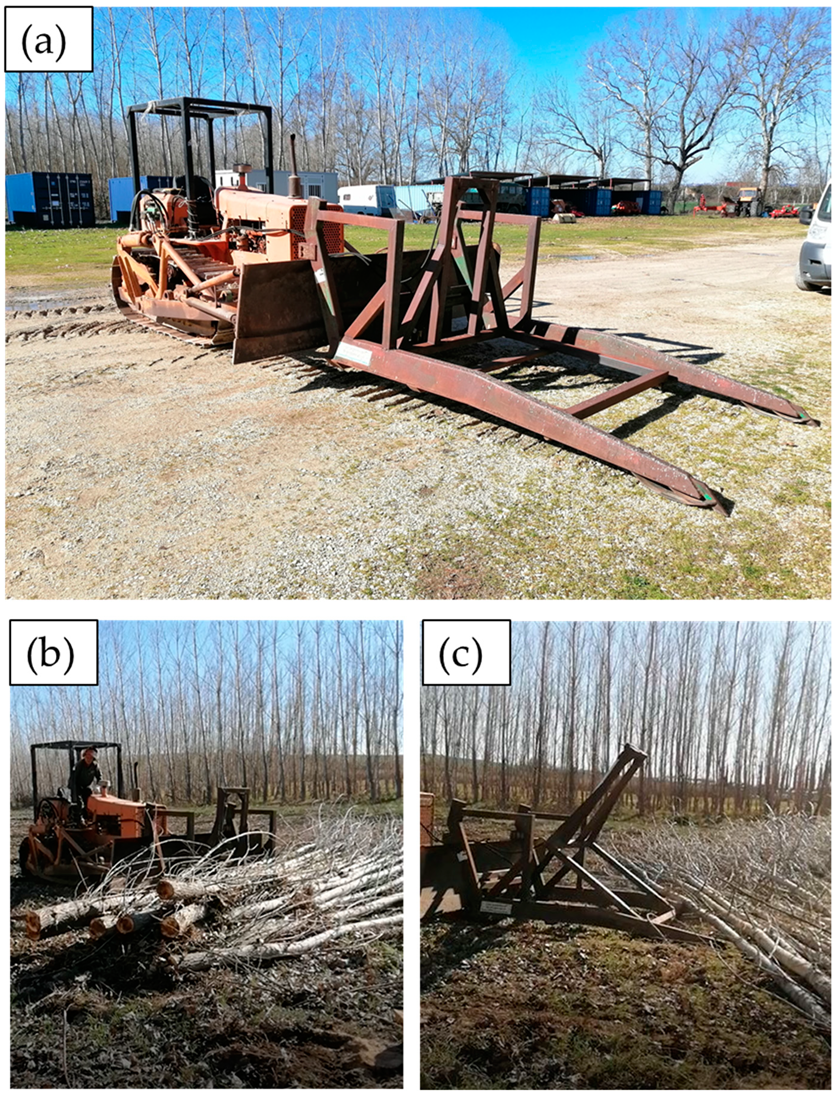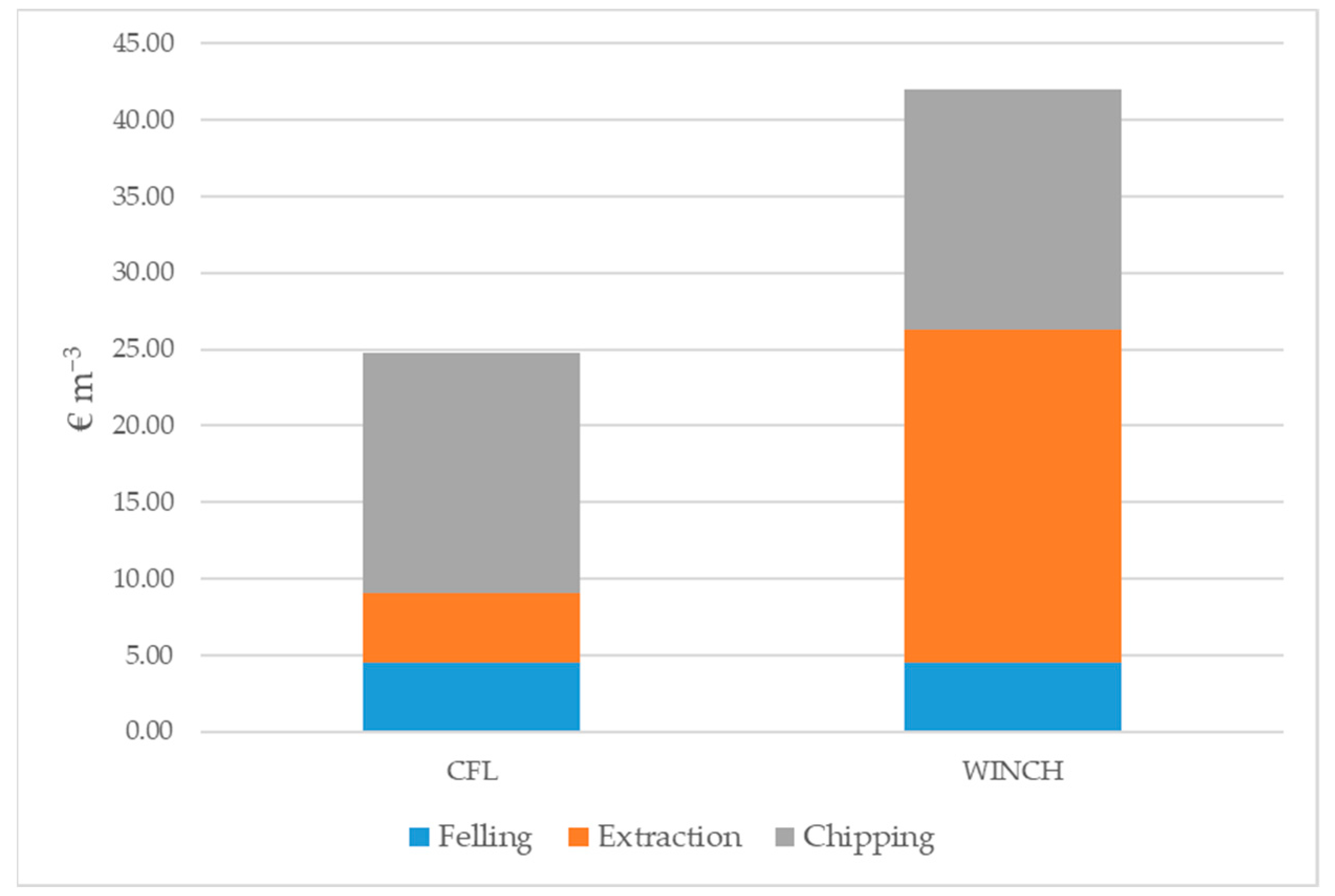Assessment of Working Performance and Costs of Two Small-Scale Harvesting Systems for Medium Rotation Poplar Plantations
Abstract
:1. Introduction
2. Materials and Methods
2.1. Study Area and Dendrometric Characteristic of the Plant
2.2. Experimental Design and Machineries Involved
2.3. Work Productivity and Costs Evaluation
3. Results and Discussion
4. Conclusions
Author Contributions
Funding
Informed Consent Statement
Data Availability Statement
Acknowledgments
Conflicts of Interest
References
- European Union Renewable Energy Directive 2018/2001/EU. Available online: https://eur-lex.europa.eu/legal-content/EN/TXT/PDF/?uri=CELEX:32018L2001&from=EN (accessed on 10 February 2020).
- European Commission Communication from The Commission to The European Parliament, The Council, The European Economic And Social Committee and The Committee of The Regions Energy Roadmap 2050. Available online: https://eur-lex.europa.eu/legal-content/EN/TXT/PDF/?uri=CELEX:5 (accessed on 10 February 2020).
- Reinhardt, J.; Hilgert, P.; Von Cossel, M. A review of industrial crop yield performances on unfavorable soil types. Agronomy 2021, 11, 2382. [Google Scholar] [CrossRef]
- Reinhardt, J.; Hilgert, P.; Von Cossel, M. Yield performance of dedicated industrial crops on low-temperature characterized marginal agricultural land in Europe—A review. Biofuels Bioprod. Biorefining 2022, 16, 609–622. [Google Scholar] [CrossRef]
- Rodrigues, A.M.; Costa, M.M.G.; Nunes, L.J.R. Short rotation woody coppices for biomass production: An integrated analysis of the potential as an energy alternative. Curr. Sustain. Energy Rep. 2021, 8, 70–89. [Google Scholar] [CrossRef]
- Fuertes, A.; Oliveira, N.; Cañellas, I.; Sixto, H.; Rodríguez-Soalleiro, R. An economic overview of Populus spp. in Short Rotation Coppice systems under Mediterranean conditions: An assessment tool for decision-making. Renew. Sustain. Energy Rev. 2021, 151, 111577. [Google Scholar] [CrossRef]
- Sperandio, G.; Suardi, A.; Acampora, A.; Civitarese, V. Environmental Sustainability of Heat Produced by Poplar Short-Rotation Coppice (SRC) Woody Biomass. Forests 2021, 12, 878. [Google Scholar] [CrossRef]
- Perdomo, E.A.; Schwarzbauer, A.; Fürtner, D.; Hesser, F. Life Cycle Assessment of Agricultural Wood Production—Methodological Options: A Literature Review. Bioenergy Res. 2021, 14, 492–509. [Google Scholar] [CrossRef]
- Eisenbies, M.H.; Volk, T.A.; DeSouza, D.; Hallen, K.; Stanton, B.; Espinoza, J.; Himes, A.; Shuren, R.; Stonex, R.; Summers, B.; et al. An assessment of the harvesting and fuel performance of a single-pass cut-and-chip harvester in commercial-scale short-rotation poplar crops as influenced by crop and weather conditions. Biomass Bioenergy 2021, 149, 106075. [Google Scholar] [CrossRef]
- Fortier, J.; Truax, B.; Gagnon, D.; Lambert, F. Thinning and Gap Harvest Effects on Soil, Tree and Stand Characteristics in Hybrid Poplar Bioenergy Buffers on Farmland. Forests 2022, 13, 194. [Google Scholar] [CrossRef]
- Olba-Zięty, E.; Stolarski, M.J.; Krzyżaniak, M. Economic Evaluation of the Production of Perennial Crops for Energy Purposes—A Review. Energies 2021, 14, 7147. [Google Scholar] [CrossRef]
- Alesso, S.P.; Tapias, R.; Alaejos, J.; Fernández, M. Biomass Yield and Economic, Energy and Carbon Balances of Ulmus pumila L., Robinia pseudoacacia L. and Populus × euroamericana (Dode) Guinier Short-Rotation Coppices on Degraded Lands under Mediterranean Climate. Forests 2021, 12, 1337. [Google Scholar] [CrossRef]
- Santangelo, E.; Scarfone, A.; Del Giudice, A.; Acampora, A.; Alfano, V.; Suardi, A.; Pari, L. Harvesting systems for poplar short rotation coppice. Ind. Crops Prod. 2015, 75, 85–92. [Google Scholar] [CrossRef]
- Saulino, L.; Allevato, E.; Rossi, S.; Minotta, G.; Fiorentino, N.; Saracino, A. Lengthening single-stem rotation improves biomass yield and water use efficiency in black poplar genotype multi-stem rotation coppice plantations. Biomass Bioenergy 2021, 154, 106256. [Google Scholar] [CrossRef]
- Stanton, B.J.; Bourque, A.; Coleman, M.; Eisenbies, M.; Emerson, R.M.; Espinoza, J.; Gantz, C.; Himes, A.; Rodstrom, A.; Shuren, R.; et al. The practice and economics of hybrid poplar biomass production for biofuels and bioproducts in the Pacific Northwest. Bioenergy Res. 2021, 14, 543–560. [Google Scholar] [CrossRef]
- Sperandio, G.; Acampora, A.; Del Giudice, A.; Civitarese, V. Models for the Evaluation of Productivity and Costs of Mechanized Felling on Poplar Short Rotation Coppice in Italy. Forests 2021, 12, 954. [Google Scholar] [CrossRef]
- Spinelli, R.; Magagnotti, N.; Lombardini, C.; Mihelič, M. A Low-Investment Option for the Integrated Semi-mechanized Harvesting of Small-Scale, Short-Rotation Poplar Plantations. Small-Scale For. 2021, 20, 59–72. [Google Scholar] [CrossRef]
- Spinelli, R.; Magagnotti, N.; Lombardini, C. Low-Investment Fully Mechanized Harvesting of Short-Rotation Poplar (populus spp.) Plantations. Forests 2020, 11, 502. [Google Scholar] [CrossRef]
- Bjorheden, R.; Thompson, M.A. An international nomenclature for forest work study. In Proceedings of the IUFRO 1995, 20th World Congress, Tampere, Finland, 6–15 August 1995; pp. 190–215. [Google Scholar]
- Spinelli, R.; Visser, R. Analyzing and Estimating Delays in Harvester Operations. Int. J. For. Eng. 2008, 19, 36–41. [Google Scholar] [CrossRef]
- Magagnotti, N.; Spinelli, R.; Kärhä, K.; Mederski, P.S. Multi-tree cut-to-length harvesting of short-rotation poplar plantations. Eur. J. For. Res. 2021, 140, 345–354. [Google Scholar] [CrossRef]
- Spinelli, R.; Magagnotti, N. Comparison of two harvesting systems for the production of forest biomass from the thinning of Picea abies plantations. Scand. J. For. Res. 2010, 25, 69–77. [Google Scholar] [CrossRef]
- Ackerman, P.; Belbo, H.; Eliasson, L.; de Jong, A.; Lazdins, A.; Lyons, J. The COST model for calculation of forest operations costs. Int. J. For. Eng. 2014, 25, 75–81. [Google Scholar] [CrossRef]
- Spinelli, R.; Magagnotti, N.; Sperandio, G.; Cielo, P.; Verani, S.; Zanuttini, R. Cost and productivity of harvesting high-value hybrid poplar plantations in Italy. For. Prod. J. 2011, 61, 64–70. [Google Scholar] [CrossRef]
- Tavankar, F.; Nikooy, M.; Latterini, F.; Venanzi, R.; Bianchini, L.; Picchio, R. The Effects of Soil Moisture on Harvesting Operations in Populus spp. Plantations: Specific Focus on Costs, Energy Balance and GHG Emissions. Sustainability 2021, 13, 4863. [Google Scholar] [CrossRef]
- Marčeta, D.; Petković, V.; Ljubojević, D.; Potočnik, I. Harvesting system suitability as decision support in selection cutting forest management in northwest Bosnia and Herzegovina. Croat. J. For. Eng. 2020, 41, 251–265. [Google Scholar] [CrossRef]
- Francesco, L.; Stefanoni, W.; Venanzi, R.; Tocci, D.; Picchio, R. GIS-AHP approach in forest logging planning to apply sustain-able forest operations. Forests 2022, 13, 484. [Google Scholar]
- Carbone, F.; Picchio, R. Operative Machinery Costs Analysis within Forest Management Implementation Frame. In Timber Buildings and Sustainability; IntechOpen: London, UK, 2019; p. 32. [Google Scholar]
- Spinelli, R.; Eliasson, L.; Magagnotti, N. Determining the repair and maintenance cost of wood chippers. Biomass Bioenergy 2019, 122, 202–210. [Google Scholar] [CrossRef]
- Laitila, J.; Prinz, R.; Sikanen, L. Selection of a chipper technology for small-scale operations—A Finnish case. J. For. Sci. 2019, 65, 121–133. [Google Scholar] [CrossRef]
- Suardi, A.; Latterini, F.; Alfano, V.; Palmieri, N.; Bergonzoli, S.; Pari, L. Analysis of the Work Productivity and Costs of a Stationary Chipper Applied to the Harvesting of Olive Tree Pruning for Bio-Energy Production. Energies 2020, 13, 1359. [Google Scholar] [CrossRef] [Green Version]
- Suardi, A.; Latterini, F.; Alfano, V.; Palmieri, N.; Bergonzoli, S.; Karampinis, E.; Kougioumtzis, M.A.; Grammelis, P.; Pari, L. Machine Performance and Hog Fuel Quality Evaluation in Olive Tree Pruning Harvesting Conducted Using a Towed Shredder on Flat and Hilly Fields. Energies 2020, 13, 1713. [Google Scholar] [CrossRef] [Green Version]
- Latterini, F.; Stefanoni, W.; Suardi, A.; Alfano, V.; Bergonzoli, S.; Palmieri, N.; Pari, L. A GIS Approach to Locate a Small Size Biomass Plant Powered by Olive Pruning and to Estimate Supply Chain Costs. Energies 2020, 13, 3385. [Google Scholar] [CrossRef]



| Cost Component | Unit | Chainsaw | Tractor for Winch and Trailer | Winch | Crawler Tractor | Fork Lift Prototype | Tractor for Chipper | Chipper |
|---|---|---|---|---|---|---|---|---|
| Investment price | EUR | 1000 | 59,071.00 | 6000.00 | 55,717.00 | 6000.00 | 122,020.00 | 20,000.00 |
| Salvage value | EUR | 0.00 | 17,448.64 | 1131.78 | 16,457.92 | 1131.78 | 36,042.77 | 2954.81 |
| Service life | Years | 4 | 10 | 10 | 10 | 10 | 10 | 12 |
| Annual use | SMH | 500 | 1000 | 1000 | 150 | 150 | 1000 | 1000 |
| Operator wage | EUR SMH−1 | 16.00 | 16.00 | 16.00 | 16.00 | 0.00 | 16.00 | 0.00 |
| Interest | % | 4 | 8 | 8 | 8 | 8 | 8 | 8 |
| Depreciation | EUR year−1 | 250.00 | 4162.24 | 486.82 | 3925.91 | 486.82 | 8597.72 | 1420.43 |
| Interest | EUR year−1 | 20.00 | 3060.79 | 285.27 | 2887.00 | 285.27 | 6322.51 | 918.19 |
| Insurance | EUR year−1 | 2.50 | 147.78 | 15.00 | 139.29 | 15.00 | 305.05 | 50.00 |
| Maintenance | EUR year−1 | 200.00 | 4730.00 | 480.00 | 51.00 | 270.00 | 9760.00 | 1330.00 |
| Fuel and lubricant | EUR year−1 | 1660.00 | 6200.00 | 0.00 | 1914.00 | 0.00 | 13,610.00 | 0.00 |
| Personnel | EUR year−1 | 8000.00 | 16,000.00 | 16,000.00 | 2400.00 | 0.00 | 16,000.00 | 0.00 |
| Overhead and profit | % | 20 | 20 | 20 | 20 | 20 | 20 | 20 |
| Overhead and profit | EUR year−1 | 2026.15 | 6863.73 | 3453.82 | 2268.23 | 215.02 | 10,923.78 | 745.99 |
| Total | EUR year−1 | 12,156.90 | 41,180.00 | 20,720.00 | 13,609.38 | 1290.11 | 65,542.10 | 4475.95 |
| Total | EUR SMH−1 | 24.31 | 41.18 | 20.72 | 90.73 | 8.60 | 65.54 | 4.48 |
| AVG | ST.DEV | |
|---|---|---|
| m3 SMH−1 | 5.43 | 1.46 |
| Mg FM SMH−1 | 4.72 | 1.27 |
| Mg DM SMH−1 | 1.88 | 0.51 |
| CFL | WINCH | Significance | |||
|---|---|---|---|---|---|
| Avg. | St.Dev | Avg. | St.Dev | ||
| m3 SMH−1 | 21.524 | 3.839 | 2.836 | 0.728 | *** |
| Mg FM SMH−1 | 18.706 | 3.337 | 2.465 | 0.633 | *** |
| Mg DM SMH−1 | 8.595 | 1.533 | 1.132 | 0.291 | *** |
| Avg. | St.Dev | |
|---|---|---|
| m3 SMH −1 | 4.477 | 1.057 |
| Mg FM SMH−1 | 3.891 | 0.919 |
| Mg DM SMH−1 | 1.787 | 0.422 |
Publisher’s Note: MDPI stays neutral with regard to jurisdictional claims in published maps and institutional affiliations. |
© 2022 by the authors. Licensee MDPI, Basel, Switzerland. This article is an open access article distributed under the terms and conditions of the Creative Commons Attribution (CC BY) license (https://creativecommons.org/licenses/by/4.0/).
Share and Cite
Latterini, F.; Stefanoni, W.; Alfano, V.; Palmieri, N.; Mattei, P.; Pari, L. Assessment of Working Performance and Costs of Two Small-Scale Harvesting Systems for Medium Rotation Poplar Plantations. Forests 2022, 13, 569. https://doi.org/10.3390/f13040569
Latterini F, Stefanoni W, Alfano V, Palmieri N, Mattei P, Pari L. Assessment of Working Performance and Costs of Two Small-Scale Harvesting Systems for Medium Rotation Poplar Plantations. Forests. 2022; 13(4):569. https://doi.org/10.3390/f13040569
Chicago/Turabian StyleLatterini, Francesco, Walter Stefanoni, Vincenzo Alfano, Nadia Palmieri, Paolo Mattei, and Luigi Pari. 2022. "Assessment of Working Performance and Costs of Two Small-Scale Harvesting Systems for Medium Rotation Poplar Plantations" Forests 13, no. 4: 569. https://doi.org/10.3390/f13040569
APA StyleLatterini, F., Stefanoni, W., Alfano, V., Palmieri, N., Mattei, P., & Pari, L. (2022). Assessment of Working Performance and Costs of Two Small-Scale Harvesting Systems for Medium Rotation Poplar Plantations. Forests, 13(4), 569. https://doi.org/10.3390/f13040569









